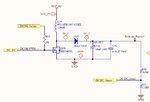alzomor
Advanced Member level 2
Hi,
I need to drive 5mAmps in a load up to 20Kohm from 9V resistor.
In order to do so I made a boost converter to boost the 9V up to 120V.

The pulse driving the MOSFET 140 micro second and the duty is 14 micro second
this was the max current in the coil = 9*14/120 = 1.05 Amp
and the average current consumed by the circuit without load = (0.5 * 1.05 * 14)/140 =52.5mAmps which is so much.
Is there any way to reduce the current consumed in the mosfet while keeping the switching frequency low to avoid EMC problems.
Regards
Hossam Alzomor
I need to drive 5mAmps in a load up to 20Kohm from 9V resistor.
In order to do so I made a boost converter to boost the 9V up to 120V.

The pulse driving the MOSFET 140 micro second and the duty is 14 micro second
this was the max current in the coil = 9*14/120 = 1.05 Amp
and the average current consumed by the circuit without load = (0.5 * 1.05 * 14)/140 =52.5mAmps which is so much.
Is there any way to reduce the current consumed in the mosfet while keeping the switching frequency low to avoid EMC problems.
Regards
Hossam Alzomor